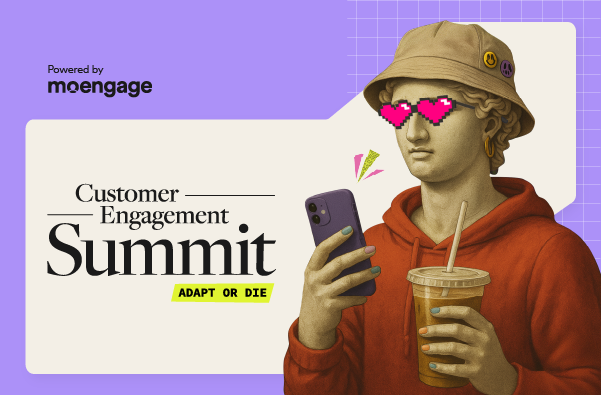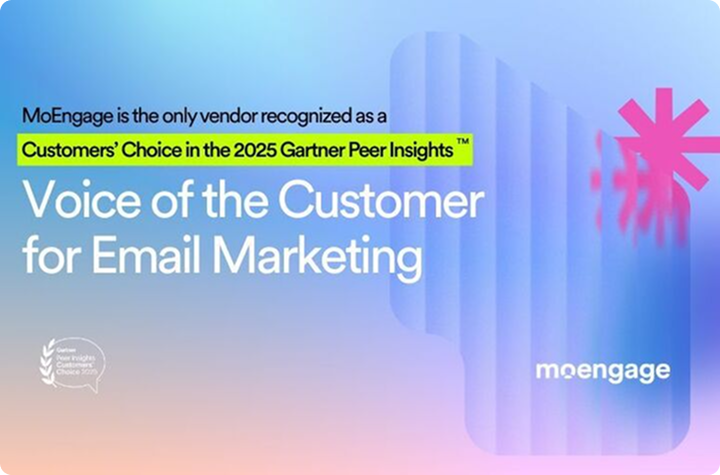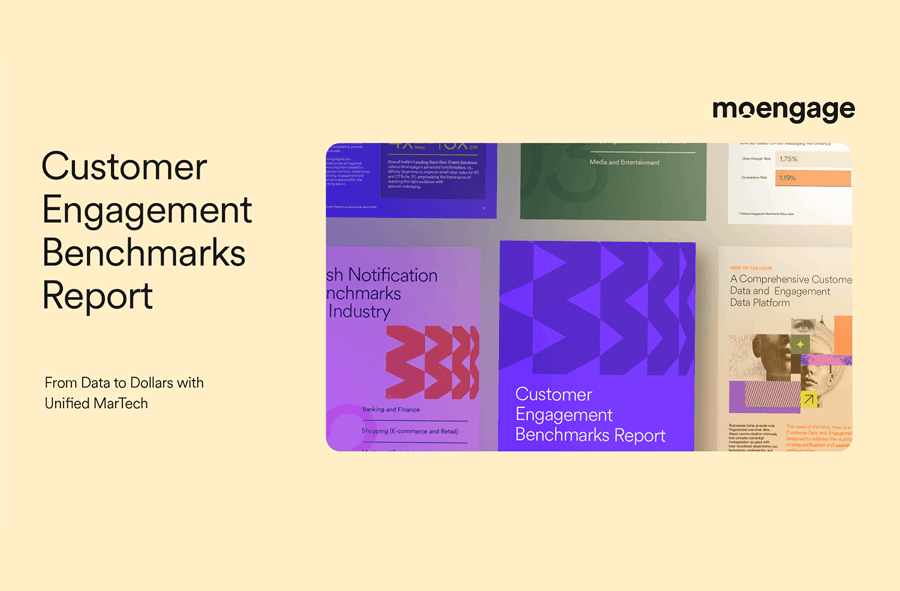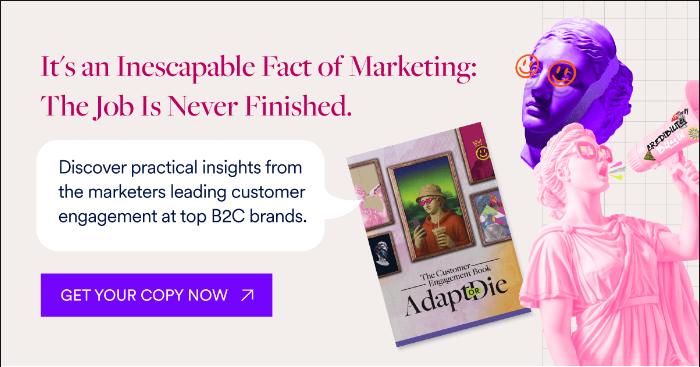Customer Segmentation and Personalization: What’s the Difference?
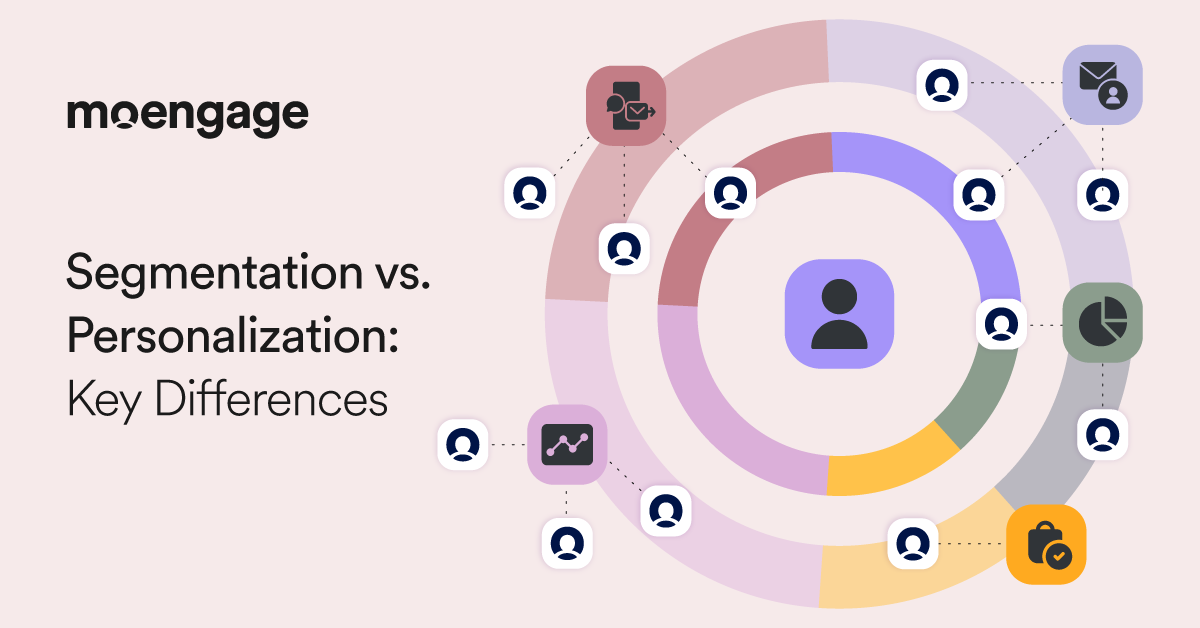
Reading Time: 10 minutes
Standing out as a brand today feels harder than ever. Competitors pop up everywhere you look, and AI tools make it simple for anyone to churn out marketing content in minutes. The secret to rising above the noise is the effective combination of customer segmentation and personalization.
When your marketing feels personal, customers notice. They feel understood. And that feeling builds customer loyalty in ways generic messaging never could.
The catch, though, is that you can’t personalize marketing effectively without first segmenting your audience. These two strategies rely on each other, and understanding their interconnection will enhance your ability to engage with customers.
In this article, we’ll break down the key differences between segmentation and personalization, show you how they work together, explain the benefits of using both, and share best practices for implementing them in your marketing.
Segmentation vs. Personalization: The Key Differences
The primary difference between customer segmentation and personalization lies in the level of granularity. Beyond that, they differ in implementation, data requirements, and scalability.
- Segmentation: Groups customers by shared traits, such as location or purchase history, allowing you to send relevant messages to hundreds or thousands of customers at once.
- Personalization: Tailors the experience to each individual customer based on their unique behaviors, preferences, and interactions with your brand.
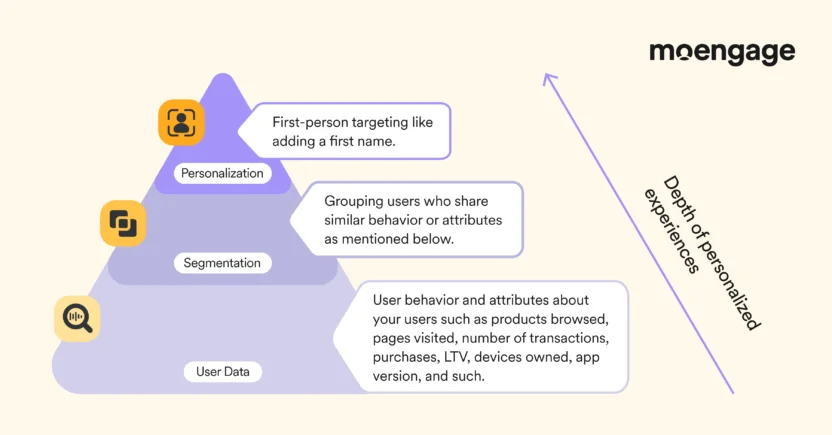
Segmentation
Segmentation takes a group approach. You examine customer data and categorize it into segments based on shared characteristics.
These segments group customers who match specific attributes. You can segment by demographics (such as age, gender, and income level), behaviors, purchase history, interests, location, or other relevant factors.
If segmentation is your only strategy, you’ll create messages aimed at entire groups.
For example, a clothing brand might send winter coat promotions to customers in colder regions. Everyone in that region receives the same message, even though one customer might prefer layering hoodies while another just bought three coats last month.
You’re treating diverse individuals as identical just because they share one attribute, missing the nuances that actually drive their purchasing decisions.
Segmentation answers broad questions, such as “Who are our customers?” and “What do different groups need?” It creates buckets that make your audience manageable.
Personalization
Personalization takes an individualistic approach. It tailors communication and experiences based on specific data, preferences, and behaviors unique to each person.
Where segmentation targets groups, customer personalization targets individuals at scale.
Using the same clothing brand example, personalization sends targeted messages to individual customers based on their browsing history, past purchases, items they’ve abandoned in their cart, and their current stage in the customer purchase journey.
On personalization, Robbie Freeman from Movable Ink talked about how setting and forgetting campaigns doesn’t cut it anymore at The Customer Engagement Summit.
Your evergreen campaigns need to be just as relevant, timely, and dynamic as the rest of your strategy, especially when resources are stretched thin and every touchpoint needs to drive value. Your abandoned cart emails from three months ago probably aren’t showing the right product information. Your welcome series might include old promos or offers that are no longer available. It’s time to let your content keep up on its own.
To create relevant and personalized campaigns, you need to do more than add your customer’s first name to an email. You’re showing them products that match their style, reminding them about items they viewed last week, or suggesting complementary pieces based on what they already bought.
You don’t have to choose between customer segmentation and personalization. You use both. How?
Segmentation and Personalization: How They Work Together
Both strategies work well on their own, but they’re most powerful when used together.
A segmentation-only strategy looks good on paper but falls short in practice. Without personalization, your messaging stays too broad. It’s like making small talk at a party: “Nice weather we’re having, right? How about those Warriors?”
This works fine for casual conversation, but when someone’s dealing with something important, generic chatter becomes annoying. It doesn’t speak to their actual needs.
Then what about going all-in on personalization without segmentation?
That path has problems, too.
Personalization without segmentation creates over-fragmented communication. Consider the practical side: you need detailed data on every single customer, and you’ll craft unique, personalized communications for each one. The inefficiency and cost add up fast.
Additionally, when every customer sees an entirely different version of your brand, your core story becomes fragmented. Over time, this confuses customers. Your brand identity blurs.
The most effective approach combines both personalization and segmentation. You benefit from each while avoiding their individual pitfalls.
Segmentation organizes your ideas and campaigns. It powers your personalization, enabling you to craft unique experiences that build real relationships with your audience.
Think of it like a train and train tracks. Tracks without trains sit there doing nothing. Trains without tracks crash.
Segmentation is the train tracks. It provides structure and direction for your marketing strategies, defines your route, and creates a clear path. It answers: “Where are we going, and which groups are we serving?”
Personalization is the train traveling those tracks. Your customers ride the same track (segment), but each one feels their journey is unique. It answers: “How do customers experience the journey?”
When you combine them, segmentation gives you the structure to stay organized and efficient, while personalization makes each customer feel like you’re speaking directly to them.
5 Benefits of Using Segmentation and Personalization Simultaneously
Let’s look at what happens when you use both segmentation and personalization together.
1. Combine efficiency and relevance
Segmentation excels at efficiency. With the right approach, you capture valuable data that groups a relatively large number of customers. Customer personalization optimizes for relevance.
Combining them becomes obvious once you see how they complement each other.
Segmentation prevents you from starting from scratch with every piece of content. Personalization ensures that each person within those segments still receives a unique experience.
MoEngage’s cross-channel marketing capabilities allow you to build personalized journeys for your customers.
Octapharma Plasma, which operates over 175 plasma donation centers across the U.S., shows the power of cross-channel marketing.
The team needed to retain donors through personalized messaging, but doing this individually for thousands of people wasn’t realistic. They segmented donors based on behaviors and engagement levels, then personalized communications within those segments using email A/B testing and multi-channel flows.
Instead of generic “Come donate” messages, partnering with MoEngage helped Octapharma Plasma send tailored content to donors based on their donation history and preferences across their preferred channels.
Email open rates jumped to 35%, conversion rates hit 35%, and month-over-month donation retention increased by 14%. Segmentation created the framework. Personalization made it relevant.
2. Promote better resource allocation
Segmentation gives you solid information about your customers. You learn who your high-value customers are, who’s casual, and who’s somewhere in between.
Combine that knowledge with personalization, and you can invest more in high-value relationships while adjusting your approach to lower-value ones.
Airlines do this well. They maintain communication with most customers, tailoring their messaging based on each customer’s flight history.
Frequent flyers get upgrade offers and exclusive lounge access. Occasional travelers get different messaging focused on booking their next trip.
This focused approach means your marketing budget goes further. You’re not treating everyone the same when they clearly have different relationships with your brand.
3. Scale personalization with consistent brand messaging
As we’ve mentioned earlier, a personalization-only strategy can make your brand messaging appear fragmented. Different customers have such varied experiences that your brand identity becomes unclear and inconsistent.
Used together, personalization and segmentation eliminate this problem.
Segmentation ensures your brand voice remains consistent across various groups. Personalization adds flexibility within that consistency.
Netflix nails this strategy. The company’s tone and design stay consistent (segmentation). However, based on viewing preferences and data, each user’s homepage appears differently (personalization). You recognize Netflix instantly, yet your experience feels custom-made.
If the Netflix example seems too far-fetched, you can learn from one of the many segmentation and personalization success stories we have here at MoEngage.
Consider the example of Outback Steakhouse. They wanted to become digital-first and provide a consistent experience on their mobile app.
To achieve this, they needed a better understanding of current customer behavior on the app and a way to utilize that understanding to create more relevant messaging.
Ultimately, Outback Steakhouse achieved this goal of personalization and consistent brand messaging by onboarding MoEngage as its customer engagement partner. They were able to use channels like push notifications, emails, SMS, and WhatsApp to launch personalized engagement campaigns.
4. Better optimization
Segmentation identifies behavioral trends and creates groups you can test against. You can run experiments on one segment without affecting the others, providing clearer data about what works.
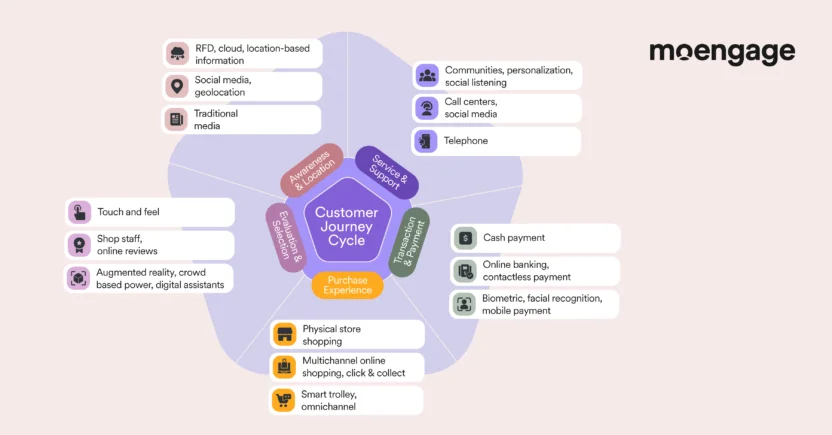
Personalization digs deeper by revealing individual triggers and preferences.
Combined, these strategies create a robust feedback system. Your marketing and product teams get clear signals about what resonates with customers and what doesn’t.
You can spot patterns faster. If personalized messages work for one segment but not another, you know where to focus your efforts. If specific personalization tactics boost conversions across multiple segments, you can scale those tactics with confidence.
This feedback loop enables continuous and data-driven optimization, rather than relying on guesswork.
5. Build a progressive relationship
Combining these strategies helps you build relationships that deepen over time.
Here’s how it works in practice:
A new customer gets minimal personalization because you don’t know much about them yet. You’re still learning their preferences and behaviors. As they engage more and more with your brand, personalization kicks in. You monitor what they browse, what they buy, and what they ignore.
As customer engagement increases, your messaging becomes more refined and targeted. You’re targeting them based on their specific interactions. Perhaps they always buy athletic gear in March, just before marathon season. Or they browse kitchen gadgets, but only buy during sales.
If they stop interacting with your brand, personalization helps you create re-engagement emails and other communications based on what interested them before. Instead of sending random “We miss you” emails, you’re reminding them about new arrivals in categories they love or offering deals on items similar to their past purchases.
This approach creates relationships that feel natural.
Another successful segmentation and personalization story comes from S’More, a next-generation dating app.
S’More’s app works differently from typical dating platforms. Users build 3D profiles with voice clips and music, rather than swiping through photos. New users needed more guidance.
S’More created personalized onboarding campaigns across push notifications, emails, and SMS. This increased Day 1 retention by 20% and boosted onboarding completions by 15%.
They also used in-app messages to introduce new features, but only to engaged users who’d completed their profiles.
As a result, users who saw these personalized messages spent 65% more time in the app.
Segmentation and Personalization Marketing Best Practices to Follow
Now that you’ve seen the segmentation and personalization benefits, let’s cover best practices for implementation.
1. First segment, then personalize
Some brands get excited and jump straight to personalization. They put the cart before the horse, and the results suffer.
Without segmentation first, customer personalization becomes unmanageable, hard to measure, and ultimately unsustainable.
Start with segmentation. Identify your vital segments based on your strategy. What groups make sense for your business? Once you’ve laid this foundation, add personalization through targeted messaging and customized experiences.
MoEngage’s web and app personalization tools can help you deliver a personalized experience for every visitor. When you start with segmentation, you can spend resources judiciously, as you already have a good framework for measuring success or scaling.
2. Start with clear objectives
Before choosing your marketing strategy, define clear goals.
What are you trying to achieve? Reduce the time between a customer’s first visit and their first purchase? Increase repeat purchases? Boost average order value? Reduce customer churn?
When you have specific targets, you can choose strategies that directly support those goals.
Personalization and segmentation offer near-endless customization options. That’s powerful, but it can also be overwhelming. Without clear objectives, you’ll spin your wheels trying different approaches without knowing if they’re moving you forward.
Clear goals keep you focused. They let you measure results against specific customer engagement benchmarks rather than vague notions of “better engagement.”
3. Respect customers’ privacy and be transparent
There’s a thin line between personalization done right and being intrusive.
Done right, personalization makes customers feel understood. Done wrong, it feels creepy, manipulative, and exhausting.
Respect privacy and be transparent about your data practices. Offer customers control over their personalization level by allowing them to opt in or out of various types of messaging.
View data regulations, such as General Data Protection Regulation (GDPR), California Consumer Privacy Act (CCPA), and even the new Telephone Consumer Protection Act (TCPA) rules, as starting points, not ceilings. Go beyond compliance to build trust.
As Megan Kwon, Director of Digital Customer Communications at Loblaw, one of the largest retailers in North America, put it at the Summit:
We don’t wanna actually cause any friction to our customers, and what we see is when those notifications are even a little bit delayed, our customers are very vocal about that. With [MoEngage] Inform, we’re actually able to bring those service levels to a place where we know with confidence that we’re actually able to deliver those timely messages, especially when it comes to Canadians’ health.
Make unsubscribing easy. One-click options in emails show respect for recipients’ time and choices. Occasionally, ask for renewed consent to use their data or send certain types of messaging.
When customers trust you with their data, they’re more likely to engage authentically. Break that trust, and you’ve lost them for good.
4. Iterate and optimize
Customers’ wants, needs, and circumstances change. What worked last quarter might not work now.
Continually refine your strategy using feedback loops from segmentation and personalization data.
Use A/B testing to compare approaches. Let AI and CRM analytics reveal patterns you might miss manually.
You should also have monthly performance reviews to check the pulse of your segments and assess whether the framework you’ve built still meets business needs. By treating segments and personalization as dynamic, you’ll keep your marketing efforts relevant and effective.
5. Don’t forget the human element
Data and automation drive customer segmentation and personalization, but don’t lose sight of the human beings behind the customer engagement metrics.
Numbers tell you what customers do. Understanding why they do it requires empathy and insight.
Use your data to inform decisions, but balance it with human judgment. Sometimes the data suggests one approach, but your team’s understanding of your customers suggests another. Trust your instincts alongside your analytics.
Also, remember that not everything should be automated. Some touchpoints benefit from genuine human interaction. A personalized email sequence works great for nurturing leads, but a real conversation might be what closes a high-value deal or saves an at-risk customer.
Use Customer Segmentation and Personalization with MoEngage
Customer segmentation and personalization aren’t competing strategies. They’re complementary approaches that work best together.
But implementing these strategies effectively requires the right tools.
MoEngage offers digital solutions that can help you segment your market and personalize their experience.
The platform provides digital solutions that enable you to segment your market and personalize experiences across multiple channels. It offers the flexibility to build sophisticated segmentation frameworks and layer personalization on top, without getting bogged down in technical complexity.
Whether you’re just starting with segmentation or looking to add deeper personalization to existing segments, MoEngage provides the infrastructure to make it happen at scale.
Book a demo to see how we can help you achieve your segmentation and personalization strategies.


